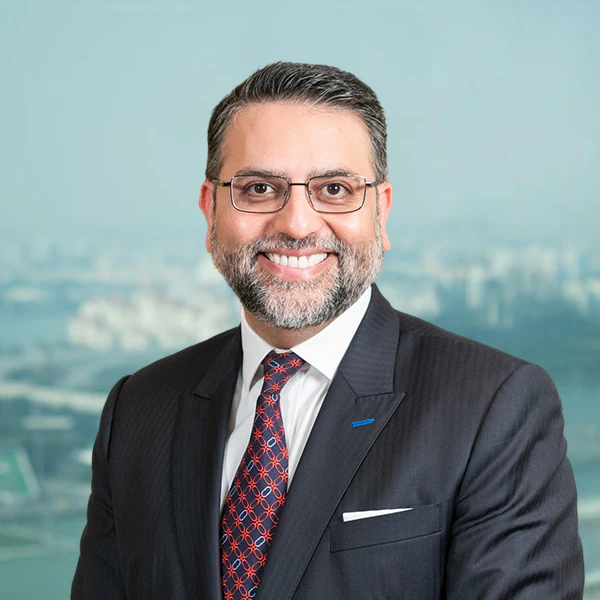Geo-political as well as pandemic induced developments over the last few years have had a transformative impact on nations, businesses, and individuals. Supply chains have not been spared from this trend and we have seen corporates rethinking their supply chain models with ‘just in case’ and nearshoring taking precedence over ‘just in time’ which had become the de rigueur model for the last few decades.
This development in supply chains has happened in conjunction with a broader shift in corporate focus towards adoption of more environmental, social and governance (ESG) practices. To be clear, sustainability had become a factor in the physical supply chain already before COVID-19 but at that time it was focussed more on the procurement team ensuring that suppliers maintained adherence to certain minimum standards, primarily from a governance perspective. COVID-19 and recent climate related changes have brought both the E and S of ESG into sharper focus in the supply chain as well.
As a consequence, pressure from stakeholders has increased and most countries have made ESG reporting for companies mandatory, or are in the process of doing so. An important part of the reporting, which is now being incorporated across the different reporting regimes, relates to Scope 3 emissions.
Scope 3 incorporates all other indirect emissions (excluding Scope 2) in the value chain, upstream and downstream, including purchased goods and services, capital goods, fuel and energy-related activities, transportation and distribution, leased assets, employee commuting, business travel, waste from operations, processing and use of products, investments and franchises.
Studies have shown that in many industries, Scope 3 emissions constitute a majority of the company’s emissions—in quite a few cases constituting over 80% of the total emissions. As a result, ESG in the supply chain has moved from being the procurement department’s sole responsibility to a cross-departmental exercise with the C-suite also involved.
Incorporating ESG into the financial supply chain
The Conference of Parties (COP21) in Paris in 2015 clearly articulated the need to align financial flows with the real economy’s efforts towards climate adaption and mitigation, and acted as a catalyst for banks to jump on the sustainability bandwagon. Most international and large domestic banks now have sustainability targets, and the next tier of domestic banks are also planning their foray into this space.
For the leaders in this space, bank-wide sustainability frameworks are in place and increasingly, ESG compliant products and solutions are now becoming available for the financial supply chain.
Multilateral development banks like the World Bank have been supporting these efforts and have also been quick in incorporating ESG in their solutions, including in supply chain financing. In Asia-Pacific, the International Finance Corporation (IFC), part of the World Bank group, has been highly active in this regard although the adoption of ESG in the financial supply chain can vary across the countries in a region as diverse as Asia Pacific.
Rajesh Mehra, International Finance Corporation’s (IFC) practice lead for trade and supply chain finance, FIG advisory for Asia Pacific, explains: “When we talk about ESG in supply chain finance (SCF) in APAC, we need to consider that different countries in the region are at very different stages of development in SCF. In many banks, the focus on ESG is broader, and it covers their micro and small and medium-sized enterprises (MSME) segments. Banks that have advanced SCF offerings often pursue their ESG strategy through an industry approach, such as agriculture.”
IFC has been supporting ESG-linked financial supply chain solutions for a few years and has already implemented multiple programmes. Two such solutions are the ones implemented for Puma and Levi Strauss.
For Puma, IFC structured an innovative supplier finance programme under which it offered financial incentives for suppliers to improve environmental, health and safety, and social standards.
In the first phase, the programme was rolled out in Bangladesh, Cambodia, China, Indonesia, Pakistan and Vietnam. IFC adopted a financing structure with tiered pricing, offering lower costs for those suppliers that achieved a high score in Puma’s supplier rating system. The ratings were assigned based on Puma’s monitoring of suppliers’ adherence to its social and environmental standards through an auditing process. From a supplier’s perspective, this programme not only helps improve their cash flow, but also provides them with a financial incentive to improve their ESG standards, which ultimately also helps reduce their operating costs.
IFC’s partnership with Levi Strauss was called the Partnership for Cleaner Textiles. The initiative supports participating suppliers in identifying and implementing actions to improve water and energy efficiency and increase their use of renewable energy. The overarching goal is to provide an additional positive incentive for suppliers to make investments that can protect against climate change, reduce water use, and keep harmful chemicals out of the supply chain. This program is under IFC’s Global Trade Supplier Finance program and provides in-depth assistance to Levi Strauss suppliers across multiple countries including India, Pakistan, Bangladesh, Sri Lanka, Mexico, Turkey, Egypt and Vietnam.
Suppliers who meet the terms of engagement and have made sufficient progress in implementing low-carbon investment plans get financing at discounted rates. Until a couple of years ago, the uptake from sustainable SCF was limited to a few early movers like Levi Strauss and Puma leading the way. Since 2021, the number of sustainable SCF programs has started to increase and banks are playing a significant role in this by establishing new programmes and migrating existing SCF programs into sustainable SCF programs.
Intent and anchor support, the building blocks
When it comes to incorporating ESG in the financial supply chain, there are two crucial building blocks: intent and anchor support.
Ricky Kaura, head of transaction banking for Asia Pacific, Africa and Middle East at Standard Chartered Bank (StanChart) remarks: “More companies are aligning on intent, as outlined in our Future of Trade report where 89% of corporates acknowledge the need for ESG solutions.”
The other critical ingredient needed to ensure a successful ESG-linked financial supply chain solution is the vision and support of the anchor client.
IFC’s Mehra says: “It’s mainly the large anchors, especially the MNCs, who are driving and supporting the ESG agenda in supply chains as it needs expertise and investment, which is difficult for small suppliers to achieve on their own.”
Moving to ESG often involves substantial investments in upgrading machinery and systems, not to mention the additional time and effort involved and is therefore made easy if the anchor client has the focus and expertise to support the suppliers on this exercise.
Some of the leading European corporates have been the pioneers on this front given the head start the European Union has had in promoting and implementing ESG initiatives and regulations.
As a sizeable proportion of sourcing still happens out of Asia and suppliers in the region start to embrace ESG in the financial supply chain, it is natural that Asian anchor clients are now having more discussions for incorporating ESG in their financial supply chain.
Challenges in implementation
While there is a massive increase in intent as well as discussions around incorporating ESG in the financial supply chain, there remain multiple challenges when it comes to actual implementation. For ESG factors in the supply chain, there are multiple areas to focus on, and corporates currently have the freedom to select issues they deem to be material.
To compound matters, there are a range of different standards covering numerous sustainability metrics, while some areas have no defined standards at all, thereby making it exceedingly difficult to have a commonly accepted way of measuring the sustainability of a global supply chain. Even once the standards are agreed on, there are additional challenges around getting access to the data and ensuring authenticity and verification from trusted third parties.
To partly address this gap, the International Chamber of Commerce (ICC) has worked with stakeholders, including banks, corporates, technology players, sustainability experts and Boston Consulting Group, to define a minimum viable, yet fully workable and implementable framework that can be applied to the textiles industry as a first use case.
The framework is intended to measure and assess the sustainability of a given trade transaction or trade finance portfolio. The aim is to create a graded framework for all transaction components across all industries that can then be used to construct aggregate assessments across whole transactions. In view of the long-term nature of the initiative, ICC is looking to develop the framework in a series of waves, iterating from an initial minimum viable Wave 1 Framework through to the target state. ICC has recently published a report sharing a progress update and outcomes from the Wave 1 pilot and intends to launch Wave 2 later this year at COP28.
Role of banks in facilitating ESG growth
Banks are also stepping up in order to address some of these challenges and assist the corporates in their journey towards a more carbon-neutral world. Some banks are also seeing sustainability as a strategic opportunity and a key differentiator to generate more business with sustainably positioned companies who are likely to favour sustainable banks as partners.
Eddy Henning, head of wholesale banking and member of the management board at ING Germany explains: “At ING, we believe that sustainable business is better business. That is why we actively support clients to improve their sustainability levels through financing and reward their efforts towards a more sustainable business. Our solutions allow our clients to strengthen their supplier base and offers financial incentives in order for their suppliers to become more sustainable.”
Banks are helping in training as well as providing advisory services in addition to increasing the portfolio of ESG-compliant solutions. The training could be bespoke or through industry events.
StanChart, for example has been having bespoke sessions with clients as well as organising treasury leadership forums where they share best practice through discussions involving ESG experts, product specialists and corporates who have implemented ESG-linked solutions.
Kaura from StanChart says: “We are helping not only with solutions but also with advisory for their broader ESG transformation strategy and roadmap, supported by experts with experience in the financial and physical supply chain ecosystem. And our solutions go deeper into their ecosystem working with partners and platforms.”
The advisory part also helps address the challenges in the implementation and facilitates the process re-engineering journey clients often need to go through to embed ESG in the financial supply chain. StanChart has its own team of specialists but also leverages its partnership with SAP Taulia to bring greater synergies between the physical and financial supply chains.
The bank is also getting into strategic partnerships with clients to drive the green agenda. It recently announced a new partnership with Ant Group aimed at driving green and inclusive finance, global fund management, and sustainable development where the two companies have agreed to deepen their collaboration and leverage their shared vision to further their cooperation in ESG, inclusive finance for small enterprises, and digital innovation.
Banks like MUFG are also helping clients in choosing as well as enhancing the appropriate ESG key performance indicators (KPI) or sustainability performance targets. This is critical to ensure that these KPI can pass the test under the ESG taxonomy which would be used for the deal structure.
Belinda Han, managing director and head of transaction banking for Asia Pacific for MUFG Bank explains: “We consider various elements of a client’s supply chain ecosystem including buyers, sellers, shipping companies, logistics providers, underlying transactions, end-purpose of the funding, specific sustainability performance targets, etc. Based on that, we provide sustainable trade finance solutions along the supply chain whether it be letters of credit, supply chain finance programmes, bank guarantees or a bilateral trade finance facility.”
Technology and partnerships in ecosystem development
With the multiple challenges associated with incorporating ESG, including the lack of universal standards, varying interpretations of ESG metrics, difficulties in getting verifiable data, there are worries around greenwashing. Banks have accordingly been extremely cautious and have a stringent process before classifying any solution as ‘green’. In the case of financial supply chain finance solutions, the fact that the underlying trade flows are more visible makes it a bit easier but challenges around getting the right data and trusted third-party verification remain. This is where technology and partnerships with other ecosystem players help.
Han explains: “We have been looking at how we can leverage technology to address the challenges around data in the supply chain. One example of this is our partnership with the Asian Institute of Digital Finance, CriAT and iAPPS-FundON for the development of GreenOn, Asia’s first digital service listing green credentials of agri-producers, which aims to provide greater transparency within Asia’s food and agricultural sector.”
GreenOn is a digital service that adopts an evidence-based, data-driven approach to analyse the initiatives of food companies and agri-producers against their sustainability objectives. By using Internet of Things to collect real-time data on the ground and working with NGOs to audit green projects’ credentials, a ‘greenness score’ is generated to evaluate the project while ensuring that the insights generated are relevant and accurate.
Technology is also at the forefront at ING. Henning remarks: “Technology is a key enabler to facilitate incorporation of ESG in the financial supply chain. An essential part of ING’s supply chain finance offering is our web-based working capital optimisation tool. Our platform connects buyers and suppliers and ensures transparency for all trade partners in the supply chain. This optimisation of the P2P process has a positive impact on working capital and supply chain stability.”
StanChart is also leveraging technologies as well as collaborative partnerships to go deeper into the supply chain and build bigger ecosystems, which help in certification and compliance. Traditional supply chain finance programmes typically only reach the first tier of suppliers, and innovative solutions are needed to get funding deeper into the supply chain. Through its partnership with supply chain technology solution provider Linklogis, StanChart is providing a sustainable supply chain financing solution that uses a digital financial token based on an irrevocable payment undertaking by an anchor buyer, thereby enabling finance to pass along the chain to several levels of suppliers.
Innovative ESG solutions
All these developments are welcome news for corporates and have led to some innovative solutions across the financial supply chain spectrum. Banks have also gone live with Sharia-compliant ESG solutions as well as transition finance facilities which help broaden the client universe that can benefit from ESG-linked financial supply chain solutions.
StanChart worked with Malaysia Airports (MAHB), one of the largest airport operator groups in the world by number of passengers handled, to structure a Sharia-compliant SCF solution which also aligns with the bank’s sustainability framework. Under the programme, SME suppliers enjoy preferential pricing compared with non-SME suppliers. The solution promotes best practices in sustainability across MAHB’s ecosystem, with automation and digitalisation embedded for improved efficiency, productivity and working capital management.
StanChart also structured a Transition Trade Finance facility to support Tung Ho Steel Vietnam. The facility will support the company’s ongoing procurement of scrap steel as part of its scrap-based Electric Arc Furnace (EAF) production. Producing new steel from steel scrap is a more environmentally friendly way of production as it is estimated that EAF emits a quarter of the carbon dioxide released by traditional blast furnaces.
Some other innovative deals from StanChart in ESG-linked financial supply chain include a trade receivable discounting deal for a company focused on the development of air pollution control materials, a solution of pre-to-post shipment invoice financing that promotes sustainable production of cotton and provides liquidity to the supplier in the pre-shipment phase, and a green guarantee for a green hydrogen project.
ING has also led the way with innovative ESG-linked solutions. One of these is a unique pilot project on embedding ESG criteria in financial markets pricing in an automated way. The bank has started this pilot in Germany whereby price quotations no longer depend exclusively on internal credit ratings and profitability ratios, but also on the current ESG performance of corporate customers. The bank is making a start with its automated e-FX trading as part of this pilot project, and other asset classes such as interest rates will follow suit.
ING also closed a unique sustainability linked derivative (SLD) with Chinese tech giant Ant Group. The SLD is an interest rate swap yield linked to Ant Group’s sustainability performance. When Ant Group achieves its targets, it is entitled to a rebate from ING. If none of these targets are met, the firm will need to pay back a pre-agreed amount to ING. The derivative incorporates a two-way incentive mechanism linked to Ant Group’s sustainability performance. The chosen KPI address major environmental and social goals set out in Ant Group’s ESG strategy. Social-impact KPI are included in the deal with the intent of leveraging Ant Group’s Alipay user base and ecosystem to encourage more green actions from communities and industries.
MUFG has also executed multiple innovative ESG deals, with a recent example being a sustainable trade finance facility for Tata Power, one of India’s leading integrated power companies. MUFG extended this financing to fund the procurement of two solar power projects, under documentary trade finance, where the company will utilise the funds towards generating renewable energy capacity. The collaboration will open further opportunities to raise green financing as Tata Power continues to increase its clean energy portfolio and contributes towards India’s net zero targets.
Real-time data and information exchange play critical role
So, what does the future hold for ESG in the financial supply chain? There are multiple developments happening across the region, which bode well for further adoption and innovation in this space.
Mehra from IFC remarks: “Real-time data and swift exchange of critical information can play a critical role in enhancing ESG in supply chain financing. The emergence of fintech and advanced SCF platforms, especially the marketplace models in SCF will help solve some of the problems which currently make it difficult to incorporate ESG in SCF programs.”
The marketplace model was already launched in India a few years back. Called the Trade Receivables Discounting System, the scope of the system was further expanded this year and is generating wide interest amongst corporates as well as banks. Across the region, other countries, including Thailand, are also keen on developing the marketplace model. The marketplace model helps in easier onboarding of suppliers, facilitates financial inclusion, and provides more competitive offerings to suppliers. It also makes it easier for fintechs to plug into the ecosystem, which would help to solve some of the existing challenges around data transparency and third-party certification.
The other development that is generating a lot of interest is the rise of digital assets that has potential uses cases in the financial supply chain as well.
Kaura from StanChart explains: “As we commercialise innovative new solutions, working with regulators, the tokenisation of assets and use of stable coin approaches can potentially help narrow the $1.7 trillion financing gap that exists today, with the transformation of trade assets into more accessible asset classes, which in turn opens up larger investor communities.”
StanChart has developed an initial token offering platform in collaboration with Linklogis to enable the issuance of asset-backed security tokens listed on the Singapore Exchange. The initial pilot demonstrated the feasibility of harnessing asset-backed tokenisation to enable investors to access yield-generating tokens tied to cashflows from underlying trade finance and working capital loans. The bank is also collaborating with the Bank for International Settlements Innovation Hub Hong Kong Centre on Project Dynamo, to explore how programmable payments can facilitate the provision of trade financing by institutional investors to SME.
As innovative technologies and marketplace models emerge, the adoption of ESG in the financial supply chain is expected to go up further.
Henning from ING remarks: “We perceive that governance around ESG is becoming more and more important and significant. In Europe, the CSRD [Corporate Sustainability Reporting Directive] initiative and in Germany the Supply Chain Act are creating a positive tension for sustainable supply chain financing. In view of the ever-increasing importance of sustainability and climate change, the number of sustainable SCF transactions is expected to grow exponentially over the coming years. We as banks play a vital role in financing the change and transition by choosing the corporates we work with, and thus incentivising efforts regarding sustainable finance, and vice versa.”
Henning has a ringside view of ESG developments as he is responsible for a market which is at the forefront of sustainability practices, and he also has a unique global perspective, having spent many years prior to this role in Asia Pacific including in China.
Having a similar bullish view on ESG development is Han from MUFG who remarks: “In the next few years, the penetration ratio of ESG linked facilities in the supply chain space will keep increasing. Efforts would be needed to drive the standardisation, transparency, re-designing of data architecture and governance around ESG data to make the process more efficient and further facilitate adoption.”
Clearly, multiple developments have brought ESG in the supply chain to the forefront of the corporate agenda. With increasing regulatory disclosure requirements, especially around Scope 3, the pressure on corporates to deliver is growing. While challenges still remain around standards, data integrity and third-party authentication, banks and industry bodies have stepped up and are helping with solutions and frameworks to make the transition smoother. The emergence of innovative technologies, marketplace models and greentech players augurs well for the development of the ecosystem. For the adoption of ESG in the financial supply chain, it is no longer about just-in-time or just-in-case, but rather as the famous slogan slays: Just Do It.
Sandeep Sethi is a consultant in Financial Services and Corporate Treasury Advisory, APAC. He is also a co-chair of the GreenTech and ESG Committee in the Fintech Association of Hong Kong








All Comments